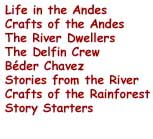|
Wednesday, August 11, 1999
Today we thought it would be nice for you to hear from the other participants
on this trip. Below are their thoughts on today's highlights.
Night Skiff Ride
At 8:00 p.m., after another beautiful sunset, Terry, Marty,
Sally, Bill, Lilia and I got on the skiff with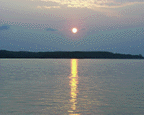 Fernando as the driver and Béder as our guide. As soon as we
left the Delfin in the small boat, dolphins started to follow. We could
hear them jumping, splashing and snorting. As we were on the way to
the tributary Yanayaquillo, Béder pointed out many of the stars
and constellations. We saw the upside down Big Dipper, the Milky Way,
Sagittarius, Scorpio, and the Southern Cross. As we entered the tributary
at a fast clip, little fish were jumping high out of the water. A couple
even jumped into the boat. Béder pointed out a small black caiman
along the bank. They can grow to 18 feet! We also saw a fish eating
a bulldog bat and several species of birds. Even though it was completely
dark, Fernando maneuvered the boat through the logs and brush in the
water. We only got stuck once for a very short time and decided to just
sit there and listen to the wildlife in the jungle. It was then time
to go back to the Delfin and end a wonderful day and prepare for our
next experience tomorrow.
Fernando as the driver and Béder as our guide. As soon as we
left the Delfin in the small boat, dolphins started to follow. We could
hear them jumping, splashing and snorting. As we were on the way to
the tributary Yanayaquillo, Béder pointed out many of the stars
and constellations. We saw the upside down Big Dipper, the Milky Way,
Sagittarius, Scorpio, and the Southern Cross. As we entered the tributary
at a fast clip, little fish were jumping high out of the water. A couple
even jumped into the boat. Béder pointed out a small black caiman
along the bank. They can grow to 18 feet! We also saw a fish eating
a bulldog bat and several species of birds. Even though it was completely
dark, Fernando maneuvered the boat through the logs and brush in the
water. We only got stuck once for a very short time and decided to just
sit there and listen to the wildlife in the jungle. It was then time
to go back to the Delfin and end a wonderful day and prepare for our
next experience tomorrow.
Pat
San Martin Village
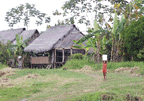 Today
we visited San Martin Village. Because the water is low, we needed to
walk out onto the skiff then onto logs to reach the shore. Many children
and adults were standing in front of us to welcome us. They were as
curious about us as we were about them. The town has a plaza with a
soccer field surrounded by buildings. One of them is a large, two level
building that houses the wildlife office and a women's club. There is
a church, an open building for celebrations, two water tanks and some
houses. Today
we visited San Martin Village. Because the water is low, we needed to
walk out onto the skiff then onto logs to reach the shore. Many children
and adults were standing in front of us to welcome us. They were as
curious about us as we were about them. The town has a plaza with a
soccer field surrounded by buildings. One of them is a large, two level
building that houses the wildlife office and a women's club. There is
a church, an open building for celebrations, two water tanks and some
houses.
As we started walking, we arrived at the school principal's home.
He welcomed us and answered some of our questions. We are giving them
the supplies we brought for this school when they get here. In the
village there is a kindergarten, an elementary school and a high school
that serves other villages in the region as well.
There is a generator for electrical power, which unfortunately has
not worked since last May. The village only had it for a little while
before it broke down. As we strolled in town, we visited a home where
17 women have established a water cooperative. They take turns filtering
the river water and distributing it. The village drinks river water,
which is not really safe to drink, so the filtering helps.
We also visited a large carpenter's shop where they make furniture
for the school and people in the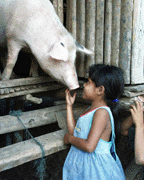 village. The wood is gathered from the surrounding areas and brought
here. The shop is running a bit slow since they have not had electricity
for the power tools since the generator broke.
village. The wood is gathered from the surrounding areas and brought
here. The shop is running a bit slow since they have not had electricity
for the power tools since the generator broke.
San Martin has 425 people. Most of the families farm, but there are
two nearby small general stores and a bar. Children played soccer,
marbles and jumping games as we took our walk around the village.
As the boat departed, I kept asking myself, if we are in the same
world, why are we so different? Is our civilization bringing progress
or disrupting their lives? Are we helping or interrupting a life style
that did not ask us to come?
Lilia
Bird Watching
We got up at 6 a.m. to do more bird watching this morning.
It was great. I got to see some new species for my life list and some
familiar ones I had seen on previous trips to the south. I have been
an avid bird watcher for seven years and have seen over 400 different
types of birds.
Some of the exciting ones were the jaribu stork which is not often
seen in the area, the black fronted nun bird, the Amazon kingfisher,
ringed kingfisher, sun grebe, wattled jacana, a russet backed oropendola,
and its long hanging nest, and the little Jesus bird that walks on
water lilies. We also saw the black collared hawk in all its beauty
several times. It was very special.
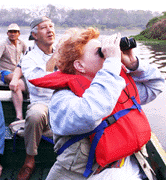 Wow,
we even saw five blue and gold macaws at one time! I would never have
believed we would have seen them so easily. It was awesome. As we
get further into the reserve and away from the villages, the macaws
begin to show up. They are big and so blue it takes your breath away.
The gold is very brilliant. As we traveled down the river more of
them appeared. Tamara thought the reason that the birds are not near
the villages is that if they are found there, the villagers often
capture them and sell them as exotic pets. It is illegal to buy animals
like this, but many people still do. Wow,
we even saw five blue and gold macaws at one time! I would never have
believed we would have seen them so easily. It was awesome. As we
get further into the reserve and away from the villages, the macaws
begin to show up. They are big and so blue it takes your breath away.
The gold is very brilliant. As we traveled down the river more of
them appeared. Tamara thought the reason that the birds are not near
the villages is that if they are found there, the villagers often
capture them and sell them as exotic pets. It is illegal to buy animals
like this, but many people still do.
Marty
Night Transmissions
Last night, while the rest of the group went out to listen
to the night sounds, Susan, Tracy and I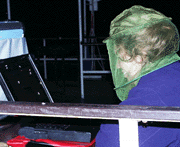 finished up the web pages, images and emails and prepared them for transmitting.
To transmit, we put everything into email as attachments and hook up
the satellite phone. From then on it is like sending a regular email
except it is really, really slow. The difficult part last night was
the bugs. We were covered in them immediately. Bugs got into my mouth,
nose and eyes. I had to stop and get the mosquito net hat you see me
wearing in the picture. The computer was so covered with bugs that at
one point I could not even see the screen to watch the mail being sent.
finished up the web pages, images and emails and prepared them for transmitting.
To transmit, we put everything into email as attachments and hook up
the satellite phone. From then on it is like sending a regular email
except it is really, really slow. The difficult part last night was
the bugs. We were covered in them immediately. Bugs got into my mouth,
nose and eyes. I had to stop and get the mosquito net hat you see me
wearing in the picture. The computer was so covered with bugs that at
one point I could not even see the screen to watch the mail being sent.
Shelly
Our Daily Rhythm
Now that we have been on the river four days we have established
a familiar rhythm. Each morning we get up at 5:30 am to go bird watching.
After bird watching we have breakfast and then begin our research. Most
days we work from breakfast to lunch, which is served at 1:00. We work
in shifts so there is some free time during the morning. After lunch
we have a two-hour siesta. People read, sleep, or write in their journals
during this time. Many of us also shower then as it is the warmest part
of the day and it is nice to cool off. There is no hot water. The shower
and the toilet are in the same tiny room. We have to be careful not
to get the toilet paper wet when we shower!
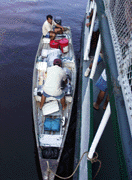 Tracy,
Shelly and I work on the getting the information ready for the daily
transmission during this time. Today we asked others if they wanted
to write something about what made the day special for them. After
siesta we get back to the dolphin research until the sun goes down
around 6:00 p.m. Sometimes we have special activities during this
time, like a visit to a village, a talk with the captain or with Béder,
our naturalist. Dinner is served promptly at 7:00 followed by an evening
activity like a slide show or night boat ride. Tracy,
Shelly and I work on the getting the information ready for the daily
transmission during this time. Today we asked others if they wanted
to write something about what made the day special for them. After
siesta we get back to the dolphin research until the sun goes down
around 6:00 p.m. Sometimes we have special activities during this
time, like a visit to a village, a talk with the captain or with Béder,
our naturalist. Dinner is served promptly at 7:00 followed by an evening
activity like a slide show or night boat ride.
After all this, the day's work is transmitted so that it can be put
on the website by the next morning. We have been very busy this week
with both the research and our project. We will certainly need a vacation
to recover from this "vacation!"
Susan
P.S. By the way, we got our luggage today! It was brought from Iquitos
in a small skiff to our boat. Everyone immediately changed his or
her clothing for the first time in a few days. We are happy campers
now!
|





